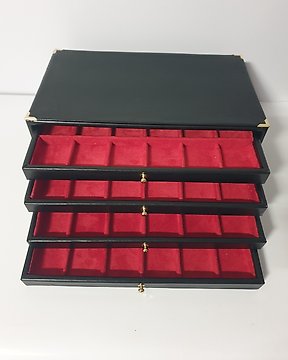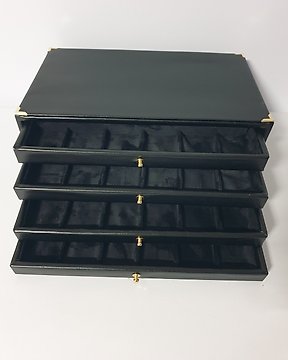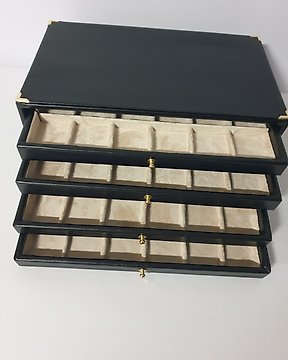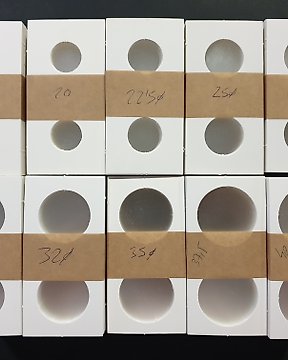Thank you very much, the goods have arrived intakt and completely. Thank you very much for the extra gift. Best regards
Katso käännösEurooppa. Extensive collection of 245+ various coins Roman Empire to present incl. many silver ones (Ei pohjahintaa)
Nro. 85742205





Must be seen. Large collection European coins including approx. 45 (!) SILVER coins.
Interesting, varied collection with many "older" coins Europe starting from the Roman Empire via late medieval 1387 up to the 18th/19th and 20th century.
All 245+ (!) coins in encased (and many times described) in coin holders / slabs.
Amongst others:
* SILVER Antoninianus in high quality Postumus (260-269 AD)
* Russia including Nicolas II last Tsar of Russia, silver and high quality Commemorative Rubles
* Medieval Hungary Sigismund (1387-1437) silver Denar,
* UK including George IV (1820-1830) , Victoria (1837-1901) and several silver coins
* Jersey, Guernsey & Isle of Man incl. Crown Size and "older" coins
* Switzerland including silver.
* Germany and France World War I Emergency coins,
* Vatican, Monaco & San Marino incl silver Lira Pope Pius IX (1846-1878)
* Belgium including Leopold II silver
* Iceland, Norway, Denmark & Sweden including silver
* Austria starting from the 18th Century incl. silver and Franz Joseph Last Emperor of Austria.
* France including silver,
* Italy including silver Victorio Emanuele III
* RARE World War I Prisoner of war camp coin,
* Dutch provincial coins including silver,
* Netherlands (Kingdom) including silver,
* Germany including States Empire Weimar and Third Reich including silver coins up to 5 Mark (!),
* approx 20% of the collection are SILVER coins
,……better dates, better qualities, , .... and many-many more.....
Please have a look at our other Catawiki auction lots for more coin collections. and/or add us to your favourites to find our future auction lots easily.
Bid with confidence. AG-Worldcoins, over 3000 lots sold on Catawiki. High feedback score.
Please evaluate this lot with reference to the images provided.
Will be sent via registered mail.
I charge only 1x shipping costs when you buy multiple lots in the same auction.
You are welcome to bid on my other items:
https://veiling.catawiki.nl/aanbod/hamaca
extra info:
The first early European modern humans appear in the fossil record about 48,000 years ago, during the Paleolithic Era. Settled agriculture marked the Neolithic Era, which spread slowly across Europe from southeast to the north and west. The later Neolithic period saw the introduction of early metallurgy and the use of copper-based tools and weapons, and the building of megalithic structures, as exemplified by Stonehenge. During the Indo-European migrations, Europe saw migrations from the east and southeast. The period known as classical antiquity began with the emergence of the city-states of ancient Greece. Later, the Roman Empire came to dominate the entire Mediterranean basin. The Migration Period of the Germanic people began in the late 4th century AD and made gradual incursions into various parts of the Roman Empire The Fall of the Western Roman Empire in AD 476 traditionally marks the start of the Middle Ages. While the Eastern Roman Empire would continue for another 1000 years, the former lands of the Western Empire would be fragmented into a number of different states. At the same time, the early Slavs began to become established as a distinct group in the central and eastern parts of Europe. The first great empire of the Middle Ages was the Frankish Empire of Charlemagne, while the Islamic conquest of Iberia established Al-Andalus. The Viking Age saw a second great migration of Norse peoples. Attempts to retake the Levant from the Muslim states that occupied it made the High Middle Ages the age of The Crusades, while the political system of feudalism came to its height. The Late Middle Ages were marked by large population declines, as Europe was threatened by the Bubonic Plague, as well as invasions by the Mongol peoples from the Eurasian Steppe. At the end of the Middle Ages, there was a transitional period, known as the Renaissance.
Early Modern Europe is usually dated to the end of the 15th century. Technological changes such as gunpowder and the printing press changed how warfare was conducted and how knowledge was preserved and disseminated. The Protestant Reformation saw the fragmentation of religious thought, leading to religious wars. The Age of Exploration led to colonization, and the exploitation of the people and resources of colonies brought resources and wealth to Europe. After 1800, the Industrial Revolution brought capital accumulation and rapid urbanization to Western Europe, while several countries transitioned away from absolutist rule to parliamentary regimes. The Age of Revolutions saw long-established political systems upset and turned over. In the 20th century, World War I led to a remaking of the map of Europe as the large Empires were broken up into nation-states. Lingering political issues would lead to World War II, during which Nazi Germany perpetrated the Holocaust. After World War II, during the Cold War, most of Europe became divided by the Iron Curtain in two military blocs: NATO and the Warsaw Pact. The post-war period saw decolonization as Western European colonial empires were dismantled. The post-war period also featured the gradual development of the European integration process, which led to the creation of the European Union; this extended to Eastern European countries after the Fall of the Berlin Wall. The 21st century saw the European debt crisis, the withdrawal of the United Kingdom from the European Union and the Russian invasion of Ukraine.
From Wikipedia, the free encyclopedia
Must be seen. Large collection European coins including approx. 45 (!) SILVER coins.
Interesting, varied collection with many "older" coins Europe starting from the Roman Empire via late medieval 1387 up to the 18th/19th and 20th century.
All 245+ (!) coins in encased (and many times described) in coin holders / slabs.
Amongst others:
* SILVER Antoninianus in high quality Postumus (260-269 AD)
* Russia including Nicolas II last Tsar of Russia, silver and high quality Commemorative Rubles
* Medieval Hungary Sigismund (1387-1437) silver Denar,
* UK including George IV (1820-1830) , Victoria (1837-1901) and several silver coins
* Jersey, Guernsey & Isle of Man incl. Crown Size and "older" coins
* Switzerland including silver.
* Germany and France World War I Emergency coins,
* Vatican, Monaco & San Marino incl silver Lira Pope Pius IX (1846-1878)
* Belgium including Leopold II silver
* Iceland, Norway, Denmark & Sweden including silver
* Austria starting from the 18th Century incl. silver and Franz Joseph Last Emperor of Austria.
* France including silver,
* Italy including silver Victorio Emanuele III
* RARE World War I Prisoner of war camp coin,
* Dutch provincial coins including silver,
* Netherlands (Kingdom) including silver,
* Germany including States Empire Weimar and Third Reich including silver coins up to 5 Mark (!),
* approx 20% of the collection are SILVER coins
,……better dates, better qualities, , .... and many-many more.....
Please have a look at our other Catawiki auction lots for more coin collections. and/or add us to your favourites to find our future auction lots easily.
Bid with confidence. AG-Worldcoins, over 3000 lots sold on Catawiki. High feedback score.
Please evaluate this lot with reference to the images provided.
Will be sent via registered mail.
I charge only 1x shipping costs when you buy multiple lots in the same auction.
You are welcome to bid on my other items:
https://veiling.catawiki.nl/aanbod/hamaca
extra info:
The first early European modern humans appear in the fossil record about 48,000 years ago, during the Paleolithic Era. Settled agriculture marked the Neolithic Era, which spread slowly across Europe from southeast to the north and west. The later Neolithic period saw the introduction of early metallurgy and the use of copper-based tools and weapons, and the building of megalithic structures, as exemplified by Stonehenge. During the Indo-European migrations, Europe saw migrations from the east and southeast. The period known as classical antiquity began with the emergence of the city-states of ancient Greece. Later, the Roman Empire came to dominate the entire Mediterranean basin. The Migration Period of the Germanic people began in the late 4th century AD and made gradual incursions into various parts of the Roman Empire The Fall of the Western Roman Empire in AD 476 traditionally marks the start of the Middle Ages. While the Eastern Roman Empire would continue for another 1000 years, the former lands of the Western Empire would be fragmented into a number of different states. At the same time, the early Slavs began to become established as a distinct group in the central and eastern parts of Europe. The first great empire of the Middle Ages was the Frankish Empire of Charlemagne, while the Islamic conquest of Iberia established Al-Andalus. The Viking Age saw a second great migration of Norse peoples. Attempts to retake the Levant from the Muslim states that occupied it made the High Middle Ages the age of The Crusades, while the political system of feudalism came to its height. The Late Middle Ages were marked by large population declines, as Europe was threatened by the Bubonic Plague, as well as invasions by the Mongol peoples from the Eurasian Steppe. At the end of the Middle Ages, there was a transitional period, known as the Renaissance.
Early Modern Europe is usually dated to the end of the 15th century. Technological changes such as gunpowder and the printing press changed how warfare was conducted and how knowledge was preserved and disseminated. The Protestant Reformation saw the fragmentation of religious thought, leading to religious wars. The Age of Exploration led to colonization, and the exploitation of the people and resources of colonies brought resources and wealth to Europe. After 1800, the Industrial Revolution brought capital accumulation and rapid urbanization to Western Europe, while several countries transitioned away from absolutist rule to parliamentary regimes. The Age of Revolutions saw long-established political systems upset and turned over. In the 20th century, World War I led to a remaking of the map of Europe as the large Empires were broken up into nation-states. Lingering political issues would lead to World War II, during which Nazi Germany perpetrated the Holocaust. After World War II, during the Cold War, most of Europe became divided by the Iron Curtain in two military blocs: NATO and the Warsaw Pact. The post-war period saw decolonization as Western European colonial empires were dismantled. The post-war period also featured the gradual development of the European integration process, which led to the creation of the European Union; this extended to Eastern European countries after the Fall of the Berlin Wall. The 21st century saw the European debt crisis, the withdrawal of the United Kingdom from the European Union and the Russian invasion of Ukraine.
From Wikipedia, the free encyclopedia
- 222
- 0
- 0
Recibido conforme. A falta de catalogar la totalidad del lote
Katso käännösKeurig bezorgd. Werd door omstandigheden iets later geleverd, maar netjes gemeld. Voor het geduld zelfs een extra munt erbij gekregen. Waar maak je dat nog mee? Top verkoper!!!! Bedankt!!!
Katso käännösPerfect !
Katso käännösPrima verzorgd, bedankt. Kreeg bonus cadeau uit 1931 nog wel, blij mee. Hoop op voorspoedig herstel. mvg jan
Katso käännösWeer keurig verpakt en geheel intact aangekomen. Zeer tevreden!
Katso käännösMooie munten, goede communicatie. Graag weer.
Katso käännösAanrader!! Netjes geregeld. Meteen een mail ontvangen wanneer het verstuurd werd. Ook nog een bonus munt gekregen! Bedankt en beterschap. Groetjes Wim
Katso käännösZeer snelle en correcte afhandeling. Prachtige munten. Top!!!
Katso käännösnetten munten
Katso käännöstop verpakt, snel en goede staat munt.
Katso käännösNice i love it
Katso käännösMooie munt en prima verpakt , verzonden !
Katso käännösKwaliteit klopt
Katso käännösNetjes verpakt, alles in goede staat ontvangen.
Katso käännösMany-many thanks for the beautiful coin, that arrived safely and rapidly. For me, here in Austria, it's a must to have at home Magna mater Austriae! Wishing you all the very best!
Katso käännösBedankt
Katso käännösThe merchandise is as advertised and is highly satisfactory. Will certainly bid with this seller again. Cheers.
Katso käännösbellissima moneta
Katso käännösReceived in great condition (well packaged), prompt delivery too. I'm very pleased. Thank you 😀 👍
Katso käännösNetjes verpakt en snel ontvangen
Katso käännösSnelle en correcte afhandeling. Mooi product Top!!!!
Katso käännösGeachte heb het pakket ontvangen hartelijk bedankt groetjes Iwan
Katso käännösHij is netjes verpakt binnengekomen heel erg blij mee super mvg
Katso käännösthank you so much👍
Katso käännös- 222
- 0
- 0
Thank you very much, the goods have arrived intakt and completely. Thank you very much for the extra gift. Best regards
Katso käännös







